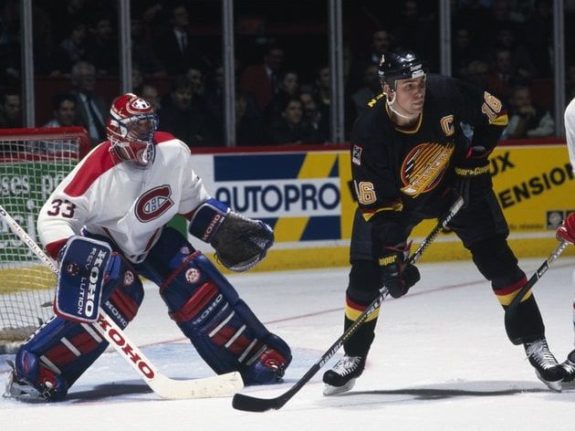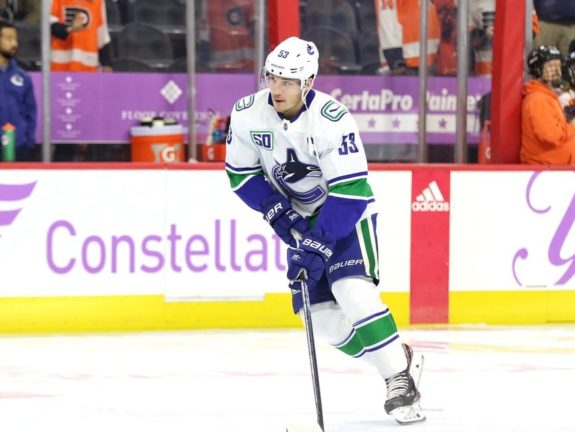Trevor Linden will forever be an icon for the Vancouver Canucks. If not for Mike Keenan, he would have also been a career-Canuck like Henrik and Daniel Sedin. Over the 16 seasons he was with the team, he recorded 318 goals and 733 points in 1140 games, along with 34 goals and 95 points in 118 playoff games. He also wore the “C” for seven of those seasons and led the Canucks to the Stanley Cup Final in 1994.
A career like Linden’s deserves to be celebrated, so in honour of his birthday (April 11, 1970), let’s take a look at five of the best moments he had in a Canucks uniform.
5. Linden’s Well-Deserved Send-Off in 2008
Although the game may not have ended in a victory or even a competitive atmosphere, Linden will remember the last game he suited up as a member of the Canucks. It was the day the NHL and the fans showed their appreciation for his many years of service.
Even though Jarome Iginla scored his 50th goal of the season, he knew that the game was more about the icon that was Linden instead of his own personal achievements. At the end of the game, he led his Calgary Flames’ teammates over to the 19-year NHL veteran and congratulated him on a career well played.
He’s [Linden] not a cheap player. He’s a good, honest player. He always plays hard and scores big goals. We have a lot of respect for him.
Jarome Iginla on Trevor Linden’s career
Everyone gave Linden a standing ovation at the end of the game, and he skated off as one of the most respected and iconic players the Canucks and the NHL had ever seen.
4. Linden’s Triumphant Return to the Canucks
After playing parts of six seasons with the New York Islanders, Montreal Canadiens and Washington Capitals, then-general manager Brian Burke put Linden back where he belonged, in Vancouver. During his final six seasons in the NHL, he never eclipsed 20 goals again, but he did provide the team with his usual indelible leadership skills and effective two-way play as a member of the bottom-six, penalty kill, and second unit power play.
Related: Canucks’ Linden Trade Continues to Give
Linden virtually became the perfect role player for the Canucks, capable of winning faceoffs, scoring the big goal in the playoffs, and providing a veteran presence in the dressing room. His hard-working nature, personality, and many years in the NHL became the template for future stars like the Sedins, who got a pep talk from him immediately after the trade that brought him back to the West Coast.
Trevor, I still remember him walking into the dressing room in Minnesota when he got traded back (in November, 2001). I didn’t know him, but I knew what he’d done in Vancouver and how big he was. That first meeting, he came up to us and just seemed so happy to meet us. I don’t know why. If things were rough for us for a few games, he was there. He just said the little things that helped. He must have seen something in us. That’s what we thought. And when you have that (belief) from someone like him, you want to prove that he’s right.
Henrik Sedin on Trevor Linden’s influence on the twins’ career
That’s who Linden was, a respected leader that kept the dressing room motivated and ready to play. A dressing room he should have never left.
3. Linden Becomes Youngest Captain in Canucks’ History
After two seasons in the NHL that saw Linden score 51 goals, he was named the Canucks’ seventh captain. He was also their youngest after Stan Smyl held the job for five seasons prior to that. At 20-years-old he was not only the youngest captain in Canucks history but also the youngest in the NHL at the time.

Linden held the captaincy for seven seasons before giving it up to Mark Messier at the beginning of the 1997-98 season. When he returned to the Canucks in 2001, he immediately took on the role of assistant captain, which he held for the rest of his career. Over the years as captain, he led the Canucks to six straight playoff appearances and a Stanley Cup Final in 1994. He also had five 30-goal seasons and led the team in scoring until Pavel Bure arrived on the scene in 1992.
To this day, he remains one of the most recognized and decorated captains in Canucks’ history and will stay that way for decades to come.
2. Linden’s #16 Gets Raised to the Rafters
On Dec 17, 2008, Linden’s legendary #16 was raised to the rafters at Rogers Arena, making him the second player to have his number retired in franchise history. He joined Stan Smyl’s #12, which was retired in 1991. Since then Pavel Bure, Markus Naslund, and the Sedins have joined them in the esteemed honour.
Related: Canucks’ 6 Retired Numbers
Until the Swedish trio of Naslund and the Sedin twins hit their stride with the Canucks, Linden held multiple records atop the leaderboard, including most goals, points, and games played. Even now, he is still fourth in points with 733, and third in goals and games played with 318 and 1140 respectively.
You may also like:
- Canucks Starting Arturs Silovs in Game 4 vs. Predators
- Canucks vs Predators Projected Lineups – Game 4
- NHL’s Longest Active Playoff Streaks
- Canucks Perform Uno Reverse to Down Predators in Game 3
- NHL Rumors: Maple Leafs, Canucks, Jets, Senators, Sabres
Linden remains the leader in playoff games played and points with 118 and 95 respectively. He also is tied for the team lead in goals (34) with Bure. To put all that in perspective, the next closest active Canuck is Bo Horvat, who has logged 11 goals and 16 points in 23 playoff games.
1. Linden Leads Canucks to Game 7 of 1994 Stanley Cup Final
There should be no doubt in anyone’s mind which moment is the greatest in Linden’s career. Even though the Canucks did not ultimately win the Stanley Cup in 1994, he laid everything out on the ice in an attempt to do so. He even played injured in Game 7, which prompted legendary broadcaster Jim Robson to belt out a sentence at the end of Game 6 that has gone down in history.
Former teammate Cliff Ronning revealed later that Linden didn’t just have a minor injury during those playoffs. He played with significant damage to his ribs, but still performed at a high level. He even scored the only two goals in Game 7 to keep the Stanley Cup dream alive. He was a warrior in every sense of the word.
You don’t know this, but Trevor Linden had cracked ribs and torn rib cartilage for the last four games of the 1994 Stanley Cup Final…You can’t imagine what it’s like to hear your captain, in a room down the hall, screaming at the top of his lungs as they injected the needle into his rib cage. Knowing him, he probably thought we couldn’t hear. He would then walk into our dressing room like nothing had happened. That was inspirational.
Cliff Ronning
Related: Remembering The 1994 Vancouver Canucks
The 1994 Canucks were a team of destiny that almost fulfilled the dreams of fans everywhere. Led by their fearless leader, they worked their butts off to prove all the doubters wrong including nearly knocking off the powerhouse New York Rangers in the Stanley Cup Final. No one thought a team that barely made the playoffs would be in that position, but this team wasn’t just any team. It was a team led by Linden, one of the most respected warriors in NHL history. Quit wasn’t in their vocabulary with him at the helm.
Linden’s Footprint Remains Today
Linden may have retired 13 years ago, but his footprint remains to this day. His influence on the city of Vancouver and the culture in the dressing room is still around. Naslund continued it with his captaincy, which flowed into Roberto Luongo and Henrik Sedin, and is now in Horvat, who is a lot like Linden in many ways.
Horvat’s warrior heart was evident in the 2020 Playoffs when he led the Canucks in goals with 10, which brought back memories of Linden’s dominance in 1994. There were times when it looked like he was going to throw the team on his back and lead them to their fourth Stanley Cup Final.

Linden and his #16 will forever be in the hearts and minds of not only Canucks Nation, but every player that steps foot into Rogers Arena. His legend and influence will never die.
You may also like:
- Canucks Starting Arturs Silovs in Game 4 vs. Predators
- Canucks vs Predators Projected Lineups – Game 4
- NHL’s Longest Active Playoff Streaks
- Canucks Perform Uno Reverse to Down Predators in Game 3
- NHL Rumors: Maple Leafs, Canucks, Jets, Senators, Sabres
